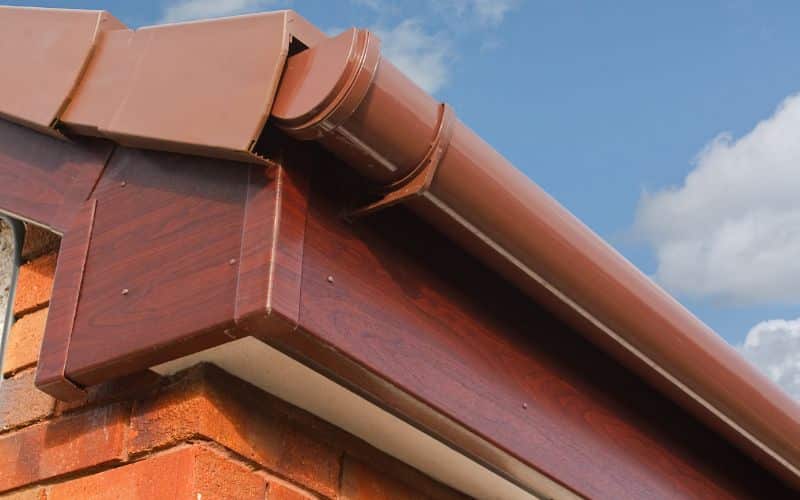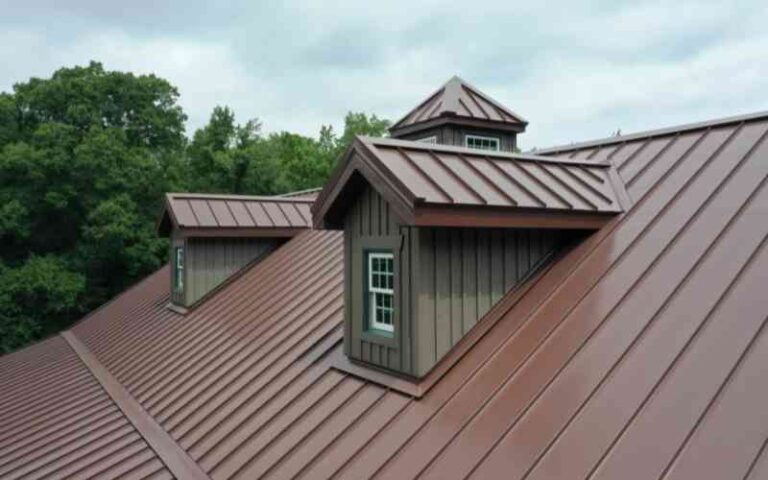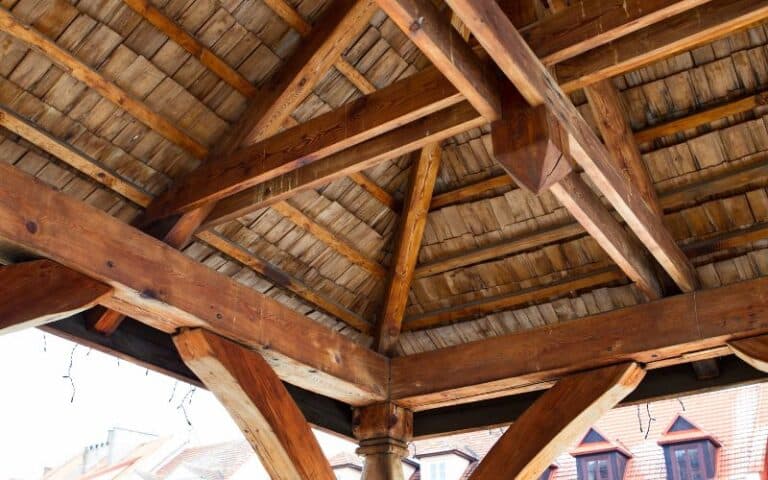Soffit and Fascia are common features of modern buildings. They provide an edgy sort of beauty to houses and their roofs.
But a space between the two of them is a bad feature. If there is a gap between the Fascia and the soffit, it is not safe and should be sealed.
Sealing gaps between the Fascia and soffit is important to prevent rodents from taking advantage of the space.
There should be no gap between the Fascia and the soffit. If your house has PVC Soffits, it should have a lip to sit on, whereas if you have a timber fascia installed, there should be a groove to slot it into! In most cases, soffit boards are supported by the Fascia’s bottom lip. As a result, they should sit together.
Ready for a Roofing Quiz?
Should There Be a Gap Between My Roof Soffit and Fascia?

No, there should be no gap between your roof soffit and Fascia. Any space invites unwanted things to find their way to your roof.
The gap can occur due to a lot of things. One of the most common is a rafter, which is longer than others. These rafters would force the soffit down.
There is often a gap between the soffit and Fascia. This space is meant to help airflow throughout the attic and helps to keep the roof decking dry.
If you want to fill the gap, use a sealant or wire mesh. Make sure to use products that are compatible with your roofing material.
Suppose you leave a gap between your roof fascia and soffit; different insects like hornets, wasps, and bees might create their home in it.
Rodents could also enter your roof and create a bigger space with their teeth and claws, apart from rodents that might find their way into your roof.
It also helps keep out the elements, like rain and snow, which can damage your roof decking and insulation.
Raindrops could also blow into it and cause unwanted and permanent damage to the soffit and Fascia.
So, what do you do with the gap? It’s ultimately up to you and your home’s specific needs. Below, we’ll give you more information on how to seal a soffit or Fascia.
Can You Fill the Gap Between the Soffit and Fascia?
The answer is yes! There are a few ways to do it, and it’s a job you can do yourself. Always use quality materials and follow the manufacturer’s instructions closely.
Houses built before 1955, in most parts of the country, are built without Fascia, so if a fascia is added later, the re-roofing might cause the gap.
How Do You Seal a Soffit?
When it comes to the gap between your soffit and Fascia, you can do a few things to seal it up. You can use caulk or silicone sealant to form a watertight barrier and prevent pests from getting in.
Another option is to use galvanized steel mesh, which will help keep animals from biting their way inside the roof. And finally, you can use expanding foam to fill in any gaps in your eaves or soffits.
- Before climbing to the soffit, Open a tube of silicone sealant.
- Please insert it into the caulking gun.
- Position the gun at the edge of the soffit.
- Trigger the caulk gun to run the silicone sealant around the gap between the soffit and the ceiling gap.
- Repeat the process till all the soffit is sealed.
- Put extra focus on the soffit joints.
- Then, caulk the rafters above the soffit from inside the attic.
- After it dries, inspect your work to ensure no cracks.
Make sure you use a high-quality caulk that will withstand weathering and extreme temperatures. And don’t forget to wear gloves and safety glasses while working!
#1. Things You Will Need to Seal a Soffit
- Pressure-treated lumber
- Exterior waterproof caulk
- Colored caulk
- Exterior silicone sealant
- Caulking gun
- Utility knife
- Ladder
The soffit is an important part of the modern structure under the roof’s eaves. Soffit usually made from Vinyl or Aluminum allows air to enter the attic through the rafters.
Sealing a soffit takes only a few minutes but can make a lot of difference and provide additional provision to your roof.
How Do You Seal a Fascia?
You can caulk the gap between the soffit and Fascia to seal it, but you should also install a drip edge to divert water away from the Fascia and soffit. Replacing a fascia board is a fairly straightforward process.
- Get rid of the existing fascia board.
- Take down the gutters and drip edge.
- Start at the end of a fascia board.
- Use the silicone caulk to prevent moisture seepage.
If the fascia board has significant decay, you may have to replace it.
- Prepare the fascia board by measuring and cutting it.
- Install the New Board.
- Install the Drip Edges and Gutters.
#1. The Equipment and Supplies Necessary to Seal Roof Fascia.
Find below all you need to complete the task of sealing your roof.
- Ladder.
- Safety apparatus.
- A new fascia board.
- Nail-removal tool
- Nail gun or hammer
- Saw
- Paint
Should I Replace The Soffit and Fascia?
Soffits and Fascia are critical components of a building’s structure. They protect the roof and keep moisture, condensation, and dampness out of the house.
Always be alert for problems. Soffits and fascias are two roof components that are commonly overlooked.
Soffit and fascia replacement at the appropriate time may save your roof from additional costly repairs.
Without Fascia and soffits, every homeowner would regularly face issues with their roof, tiles, roof void, and guttering, and you wouldn’t want that.
The soffits and fascias of your roof also play a key role in maintaining the roof’s structural integrity.
If the wood frame is exposed to rain, mold may form; this mold can quickly spread and damage the wood.
#1. Signs That Your Soffit and Fascia Needs Replacement
- Flaking paint
- Leaks
- Rotted wood
- Fungus growth
- Sagging sections
- Rodents Marks
How much does it cost to replace the soffit and Fascia?
The cost depends on many things like which part of the country you are located in, the material you use, and the type of contractor you hire.
#1. Soffit Price Per Foot
| Soffit | Prices |
|---|---|
| Aluminum | $7-$21 |
| Vinyl | $4-$9 |
| Wood | $1-$3 |
#2. Fascia Price per foot
| Fascia | Prices |
|---|---|
| Aluminum | $8-$20 |
| Vinyl | $5-$8 |
| Wood | $1-$3 |
Materials used for Soffit and Fascia
Various materials can be used for soffit and Fascia. They’re all good, but each has its pros and cons.
Below are examples of some,
#1. Vinyl
A vinyl needs constant checking to ensure it stays in good condition. Vinyl is easily damaged by the sun and other natural elements. For medium-term durability, it is your best choice.
#2. Wood
Woods must be treated, caulked, and painted for them to last long. They are very susceptible to mold. Fire can easily fall apart from rodents tampering.
However, if you can consistently keep a good eye on them, they are an attractive material for your roof.
#3. Aluminum
Aluminum offers a long-term solution and easy maintenance for your Soffit materials.
Its durability makes up for its price difference from other materials. It is your best choice for a fire-resistant, long-lasting Fascia material.
Read More: All You Need To Know Durabond For Large Gaps
Conclusion
There are a few reasons you might want to leave a gap between your roof soffit and Fascia. Some people prefer to have a gap so that air can circulate.
Sealing the gap can help keep moisture and pests out of your home. Soffit and fascia replacement at the appropriate time may save your roof from additional costly repairs.






